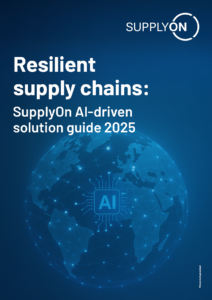Are you collaborating already, or do you just exchange data?
![]()
In spite of the continuing spread of the Internet and the associated improvements to companies’ electronic networks, business processes are still largely based on the exchange of unstructured data by e-mail or even fax.
This may well surprise us, particularly as the fourth industrial revolution, ‘Industry 4.0,’ was proclaimed some time ago,together with the ‘Internet of Things,’ which is intended to link intelligent objects and enable them to communicate, “bridging the information gap between the real and virtual world” as the German Wikipedia entry puts it. In the day-to-day business of operational procurement, reality still lags very far behind these aims and ambitions.
For example, customers send their orders to suppliers by fax, these then enter the order data manually into their own inventory management or ERP system, print out an order confirmation, and send it to the customer through the post. There, somebody tears open the letter and enters the details of the order confirmation into their ERP system so that their own organization has access to this important order data. This way of passing data around is full of media breaks at every stage, from advance shipping notifications (ASNs) through goods receipts right down to invoicing. The more media breaks there are and the more unstructured data formats are used (e-mail, text documents, PDFs, bitmaps, etc.), the greater the manual effort that is needed.
Only the very largest companies, mostly OEMs, manage to handle at least a portion of their overall processes via EDI, i.e., without media breaks. These companies possess the necessary technical know-how, the cost-intensive infrastructure needed to use electronic data exchange, and the personnel required for such an operation. And especially in the automotive industry, they have the good fortune that most of their suppliers are themselves financially sound global players that are also in a position to implement and operate such EDI systems. Things are not so rosy for medium-sized OEMs and tier 1 companies, where the proportion of suppliers who are able (and willing) to use EDI is generally only between 10 and 20%. Most suppliers still communicate only via e-mail and fax. Seen from here, a consistently implemented ‘Industry 4.0’ concept that also involves the networking of companies is about as far away as the latest iPad Air with Retina display is from the slide rule.
And even with comprehensive integrated process management using EDI, there are numerous relevant supply chain problems that you would not be able to identify early enough to eliminate them. Why is that?
Standalone processing prevents taking a common view
Communication via EDI is the exchange of data between separate software systems, often ERP systems, with standalone processing and interpretation of the transferred information. One side generates business information in structured formats and transmits it to their business partner (customer, supplier, carrier, etc.). There the information is stored and analyzed, and depending on the relevant business process, the first side then receives an appropriate response. In this scenario, the assessment of how far the requirements stated in the initial message can be met is not made by business partners collaboratively with a shared view of the process situation at the interface. This can lead to misunderstandings, costly negotiations, and delays in identifying and eliminating critical situations.
Collaboration facilitates effective and efficient process handling for both business partners, but this calls for a shared view of the situation at the interface, and EDI communications between standalone ERP systems simply cannot provide that.
The common goal: to increase competitiveness
The European aerospace industry recognized this several years ago. Initiated by Airbus, a consortium of leading aerospace companies decided that the many individual supplier platforms attached to the companies’ various ERP systems should be replaced by a standardized collaboration platform. Their primary aim was not to make the individual companies more efficient and competitive, but to give the entire European aerospace sector an advantage when competing with North American companies.
The result of this initiative was AirSupply, a collaboration solution for operational procurement. One striking feature of AirSupply is that it is the leading component in collaborations between purchasing companies and suppliers. The data required for the collaboration process is transferred from their ERP systems, either via EDI or by upload, after which AirSupply organizes the actual collaboration. Once the result of the collaboration is available, the information is returned via EDI or download to the individual ERP systems. This film illustrates how the solution is used and what benefits it offers:
Save administrative effort
What is more, EDI-based data exchange is limited almost exclusively to operational procurement. For processes that are per se collaborative in nature, passing data and documents back and forth in this way has similar shortcomings. One example is the APQP process, which deals with the joint operation of lengthy product development processes between business partners involving an extremely comprehensive exchange of documents.
These are liable to change over time and therefore need versioning. Experience shows very clearly that managing projects by exchanging individual documents (project plans, drawings, specifications, work results, etc.) and storing and processing them in separate IT infrastructures leads to a lack of transparency, high administrative outlay, and in some cases extremely costly project delays.
Joint collaboration platforms can rectify this situation. They create transparency by giving all parties a common view of the process or project. In this way they also permit true collaboration, which in turn enables problems to be promptly identified and readily resolved. When they are made available in SaaS mode, they reduce the complexity on both sides and allow even the smallest company to participate in software-supported processes without having to run any complex IT projects, enabling them to realize considerable process savings and improvements.
What about you? Do you already collaborate with business partners, or do you just exchange data?





